Do you have oily skin or oily shine, especially in the T-zone area, a few hours after washing or even immediately after washing your face? Or does your skin seem dry, dull, tight, and have signs of premature aging? If it’s the latter, then you may have dry skin.
I have suffered from dry skin my whole life, especially in the cold winter months. So what procedure do I follow and recommend? How to hydrate dehydrated skin? Follow these 8 steps to hydrate your dry or dehydrated skin:
- Cleanse
- Exfoliate
- Apply an Essential Oil
- Use a Facial Steamer (Bonus/Optional)
- Use a Gel Mask (Bonus/Optional)
- Apply a Serum
- Apply a Toner
- Apply a Moisturizer
If you look closely at your skin, you can tell if you have a dry skin type. If you kind of push and manipulate your skin, and you see those little crinkles, or if you pinch your skin and it kind of holds its shape, and it doesn’t bounce back… this type of skin is dehydrated skin.
Hydrated skin looks soft supple, and it bounces back smooth and glowing without looking oily or greasy. Now, there are more in-depth ways to tell the difference between hydrated and dehydrated skin. For this, you would want to see a dermatologist, and they can determine the types of skin you have in different parts of your face and body.
Today, I’m going to be talking about how I rehydrate my dehydrated skin with basic home remedies that are fairly simple and easy. Most times, people will rush to the store to find a magic bullet cream or ointment.
It is important to have the right products, but what is equally important is the order in which you use them and the consistency of use. As well as avoiding any bad habits which we talked about in the previous post. I learned this the hard way after going through many very cold, dry, dehydrated skin winters. If you suffer as well as me, read on to learn how to hydrate dehydrated skin with 8 simple steps.
How to Hydrate Dehydrated Skin – Our 8 Steps
1. Cleanse
The first thing that you will do is double cleanse your face. Clean your face thoroughly and remove any makeup. Do it again because the second cleanse actually cleanses your skin. Remember to not use any harsh chemicals or soaps that can irritate your skin.
2. Exfoliate
After cleansing, exfoliate your face and also your neck. Make sure you cleanse and exfoliate your face as well as your neck because a lot of people forget the neck. I don’t recommend any harsh bristle brushes. Try to use softer brushes, and don’t use too much pressure, or you can damage your skin. Once you dry off your face, then you’re ready for the oil infusion treatment.
3. Apply an Essential Oil
Take a couple of drops of facial oil, such as jojoba oil. We mentioned some great oils in a previous post for best facial oils for dry & aging skin and even acne skin. You can use a couple of drops of those oils and slowly massage them into your skin.
4. Use a Facial Steamer (Bonus/Optional)
To enable the moisture to penetrate further into the skin, you can use a facial steamer. It isn’t necessary, just a bonus to get even better results. Turn the steam on and make sure you’re at a safe distance away from the steamer. Steam your face for about ten to fifteen minutes. Do not steam longer than that because we don’t want to over dehydrate your skin.
The combination of heat and moisture helps facilitate the oil to restore some of your skin’s bare barrier and starts to repair it. After ten to fifteen minutes, you have enough moisture on your face to facilitate more penetration of the products that you’re going to be using in addition to the oil.
See the below video for other tips on hydrating dehydrated skin:
5. Use a Gel Mask (Bonus/Optional)
Instead of jumping right into your serum, toner, and cream, you can actually use a water-based gel mask. Like a facial steamer, I don’t always use a gel mask, but it does help. These masks work really well and can be left on overnight.
Apply a very thin water-based gel mask on your face, and then leave that on overnight. These are okay to put on your eyelids. Put a very thin layer over your lips as well and leave that on overnight.
If your skin is really dehydrated most of that will have evaporated, if not all, by the next morning. So, the difference is that you’re not going to be adding on toner or serum or cream because you’re going to be leaving that mask on as an overnight treatment. If your mask needs to be removed, then go ahead and spray the toner with the serum and then your night cream.
When finding a gel mask, here are some ingredients that you want to look for. Make sure they’re at the top of the ingredients list, which means there is a lot in there. What you want in there are humectants. They draw moisture to the skin and actually stay on the skin. A lot of times, when you’re using a hydrating gel mask, they’ll have ingredients that are anti-inflammatory and bring down redness.
When your skin is dehydrated, it also has some inflammation, so what you want to look for are ingredients that draw moisture to the skin. One of these ingredients is called beta-glucan.
Beta-glucan is a humectant derived from plants, which helps to maintain a smooth, healthy, and youthful skin appearance and promotes collagen building. It also helps to heal the skin from sun damage, rashes, mild burns, and wounds.
6. Apply a Serum
Next, we’ll apply a serum. Face serums are lightweight moisturizers that penetrate deep to deliver active ingredients into your skin. Consistent use of a serum regularly can give your skin a firmer, smoother texture, make pores appear smaller, and keep your skin hydrated.
Depending on the serum, you may have to wait 10 to 15 minutes for it to penetrate. If it’s a hyaluronic acid serum, you can go ahead and put that on while your face is still saturated.
7. Apply a Toner
Next, we’ll apply a toner. Choose a spray toner, not the cotton one, because the cotton one will remove all of what you just applied to your face. Make sure that it actually increases the efficacy of the products that you are using as well as increases your skin’s ability to hold in that moisture.
A face toner helps to get rid of excess dirt, traces of oil, and makeup, correct and balance the pH of your skin, and helps manage acne. In other words, a facial toner thoroughly cleans the skin and helps remove built-up surface dead skin cells.
There are several reasons why you have to avoid cotton toner. The first one is a lot of the toner gets into the cotton ball than on your skin. The second one is a lot of people use cotton balls regularly to wipe down the soap residue, thus stressing out the tissues of the skin over time.
With a spray toner, you get a more even product on your face, and you will not have to wait until it dries or evaporates. Your face will still be saturated with 7 to 10 sprays.
Most people usually apply moisturizer or cream to their faces. However, there are a lot who neglect to apply toner. Toner is important because it will re-establish and readjusts your pH. It also helps your skin’s ability to retain and hold in moisture and increases the efficacy of any serums that you’re using.
Whether it’s acne hyperpigmentation aging, or just very dry skin, use a toner that’s specific to your skin condition. For example, if you use anti-inflammatory serum or cream, use a toner that increases the anti-inflammatory ingredients in those products. If you have acne-prone skin, use an acne-fighting toner.
8. Apply a Moisturizing Cream
In the final step, while your face is still saturated, apply your favorite moisturizing cream to seal in all the moisture that you had put onto your face. You don’t have to pick a very fancy cream, just one that feels right with your skin. I have used Aveeno Daily Moisturizer for a while but use whichever feels best and try to avoid products with too many ingredients and chemicals.
See the below video for even more tips on hydrating dehydrated skin:
Conclusion – How to Hydrate Dehydrated Skin?
So how to hydrate dehydrated skin? Follow these 8 steps:
- Cleanse
- Exfoliate
- Apply an Essential Oil
- Use a Facial Steamer (Bonus/Optional)
- Use a Gel Mask (Bonus/Optional)
- Apply a Serum
- Apply a Toner
- Apply a Moisturizer
Related Questions
How long does dehydrated skin take to heal? It can take about 14 days for dehydrated, dry skin to heal. This depends on the procedure you follow, the type of ingredients, and the consistency of use. Once healed, you should keep following a routine of applying products that are beneficial for your skin.
What is the difference between dry and dehydrated skin? Dry skin is a type of skin (as opposed to oily or combination skin), but dehydrated skin is a condition anyone can get. Those with a dry skin type regularly have a lack of oils in the skin. Dehydrated skin isn’t as bad and is often just a lack of water in the top layer.
Does drinking water help dehydrated skin? If you’re severely dehydrated, then drinking a lot of water will help to rehydrate your skin. But most people are normally hydrated. Therefore, according to UAMS dermatologist Dr. Donna Pellowski, drinking a lot of water will not make much of a difference for most people’s skin.

![Neutral Skin Tone Defined [and Best Colors for Neutral Skin] neutral skin tone](https://skincaregeeks.com/wp-content/uploads/2021/05/neutral-skin-tone-150x150.png)





![Read more about the article Hot Spoon Mosquito Bite Treatment [Does It Help and How To]](https://skincaregeeks.com/wp-content/uploads/2021/05/hot-spoon-mosquito-bite-300x200.jpg)

